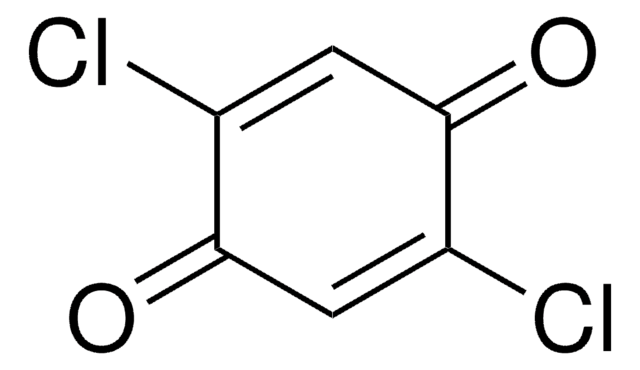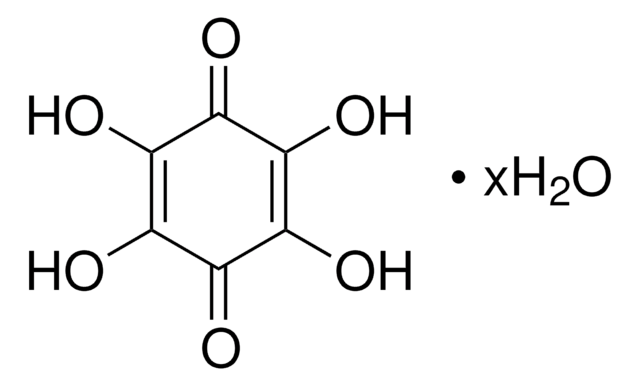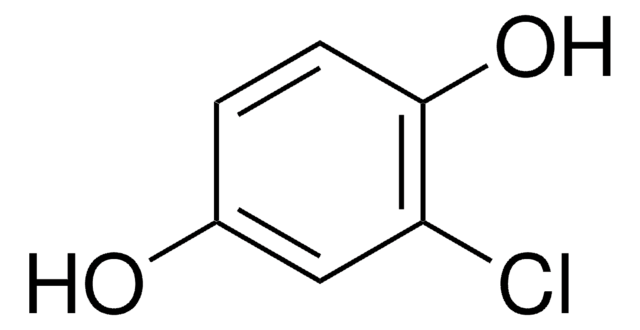431982
2,6-Dichloro-1,4-benzoquinone
98%
동의어(들):
2,6-Dichloro-2,5-cyclohexadiene-1,4-dione, 2,6-Dichloro-p-benzoquinone, 2,6-Dichlorobenzoquinone, 2,6-Dichloroquinone
로그인조직 및 계약 가격 보기
모든 사진(1)
About This Item
실험식(Hill 표기법):
C6H2Cl2O2
CAS Number:
Molecular Weight:
176.98
EC Number:
MDL number:
UNSPSC 코드:
12352100
PubChem Substance ID:
NACRES:
NA.22
추천 제품
Quality Level
분석
98%
mp
122-124 °C (lit.)
SMILES string
ClC1=CC(=O)C=C(Cl)C1=O
InChI
1S/C6H2Cl2O2/c7-4-1-3(9)2-5(8)6(4)10/h1-2H
InChI key
JCARTGJGWCGSSU-UHFFFAOYSA-N
관련 카테고리
일반 설명
2,6-Dichloro-1,4-benzoquinone (DCBQ, 2,6-DCBQ) is a halobenzoquinone. Halobenzoquinones are disinfection byproducts (DBPs) found in drinking water. They are capable of producing reactive oxygen species and causing oxidative damage to proteins and DNA in T24 human bladder carcinoma cells. UV-induced transformation of DCBQ in drinking water has been reported. Detection of DCBQ in drinking water by liquid chromatography-ESI tandem mass spectrometry has been reported.
애플리케이션
2,6-Dichloro-1,4-benzoquinone is the suitable reagent used to in a study to evaluate the diffusion coefficients (D) for a family of quinones, nitroaromatics, ferrocenes and aromatic hydrocarbon compounds, in acetonitrile by single potential step chronoamperometry. It may be used in the preparation of :
- 2,3,5-Trichloro-1,4-dihydroquinone
- 2,3,5-trichloro-1,4-benzoquinone
- 2,6-Dichloro-1,4-dihydroquinone
신호어
Warning
유해 및 위험 성명서
Hazard Classifications
Eye Irrit. 2 - Skin Irrit. 2 - STOT SE 3
표적 기관
Respiratory system
Storage Class Code
11 - Combustible Solids
WGK
WGK 3
Flash Point (°F)
Not applicable
Flash Point (°C)
Not applicable
개인 보호 장비
dust mask type N95 (US), Eyeshields, Gloves
이미 열람한 고객
Yasuhiro Kashino et al.
Biochemistry, 41(25), 8004-8012 (2002-06-19)
A highly active oxygen-evolving photosystem II (PSII) complex was purified from the HT-3 strain of the widely used cyanobacterium Synechocystis sp. PCC 6803, in which the CP47 polypeptide has been genetically engineered to contain a polyhistidine tag at its carboxyl
Denis V Yanykin et al.
Biochimica et biophysica acta, 1797(4), 516-523 (2010-01-26)
Oxygen consumption in Mn-depleted photosystem II (PSII) preparations under continuous and pulsed illumination is investigated. It is shown that removal of manganese from the water-oxidizing complex (WOC) by high pH treatment leads to a 6-fold increase in the rate of
I Yruela et al.
The Journal of biological chemistry, 266(34), 22847-22850 (1991-12-05)
Oxygen evolution by photosystem II membranes was inhibited by Cu(II) when 2,6-dichlorobenzoquinone or ferricyanide, but not silicomolybdate, was used as electron acceptor. This indicated that Cu(II) affected the reducing side of the photosystem II. The inhibition curves of Cu(II), o-phenanthroline
Understanding the linear correlation between diffusion coefficient and molecular weight. A model to estimate diffusion coefficients in acetonitrile solutions.
Valencia DP and Gonzalez FJ.
Electrochemical Communications, 13(2), 129-132 (2011)
Ben-Zhan Zhu et al.
Proceedings of the National Academy of Sciences of the United States of America, 104(10), 3698-3702 (2007-03-16)
The metal-independent decomposition of organic hydroperoxides and the formation of organic alkoxyl radicals in the absence or presence of halogenated quinones were studied with electron spin resonance (ESR) and the spin-trapping agent 5,5-dimethyl-1-pyrroline N-oxide (DMPO). We found that 2,5-dichloro-1,4-benzoquinone (DCBQ)
자사의 과학자팀은 생명 과학, 재료 과학, 화학 합성, 크로마토그래피, 분석 및 기타 많은 영역을 포함한 모든 과학 분야에 경험이 있습니다..
고객지원팀으로 연락바랍니다.












